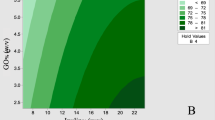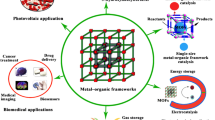Abstract
Urea is a widely used source of nitrogen, but its rapid solubilization in water leads to significant wastage on application. Thus, the quest for an efficient and economical polymeric matrix able to encapsulated urea is a long-standing challenge. In this paper, we present a simple and economical method for urea entrapment in cellulose acetate (CA) microparticles produced by the electrospraying process. The morphology and diameter of the microparticles were optimized experimentally by evaluating the solvent composition (binary mixture) and polymer concentration. The electrospraying process parameters, such as particle collection distance, applied voltage and flow rate, were also evaluated. The particle diameter was determined by scanning electron microscopy (SEM) and the CA microparticle characteristics, urea incorporation and in vitro release profile were determined by Fourier transform infrared (FTIR) spectroscopy and differential scanning calorimetry (DSC). The morphological characteristics (shape and porosity) of the CA microparticles were affected by the diffusion rate and CA solubility due to solvent evaporation in the electrospraying process. The SEM images showed monodispersed and spherical CA microparticles with a diameter size of 2.2 ± 0.3 µm. The FTIR spectra and SEM images verified the urea entrapment in the CA microparticles (100 mg/g), and the particle morphology did not appear to be affected. The release of urea from the CA microparticles showed a maximum of 79% after 7 h, which is a significant difference in relation to in vitro urea release. The results obtained using the electrospray technology represent a step forward in the search to improve the incorporation of urea into CA microparticles.








Similar content being viewed by others
References
Backac, A (2010) Physical inorganic chemistry: reactions, processes and applications. Willey 2010
Zhang S, Cheng L, Guo X, Ma C, Guo A, Moonsan Y (2016) Effects of urea supplementation on rumen fermentation characteristics and protozoa population in vitro. J Appl Anim Res 44:1–4
Koli, P, Bhardwaj, NR and Mahawer, SK (2019) Agrochemicals: Harmful and Beneficial Effects of Climate Changing Scenarios. Clim Chang Agri Ecosyst, 65–94
Rockström J, Steffen W, Noone K, Persson Å, Chapin FS, Lambin E, Lenton TM, Scheffer M, Folke C, Schellnhuber H, Nykvist B, Wit DE, CA, Hughes T, Van Der Leeuw S, Rodhe H, Sörlin S, Snyder PK, Costanza R, Svedin U, Falkenmark M, Karlberg L, Corell RW, Fabry VJ, Hansen J, Walker B, Liverman D, Richardson K, Crutzen P, Foley J, (2009) A safe operating space for humanity. Nature 461:472–475
Alcarde JC, Guidolin JÁ, Lopes A (1998) Os adubos e a eficiência das adubações, 3rd edn. ANDA, São Paulo
Sempeho SI, Kim HT, Mubofu E, Hilonga A (2014) Meticulous Overview on the Controlled Release Fertilizers. Adv Chem 2014:1–16
Wang W, Zhang MJ, Chu LY (2014) Functional Polymeric Microparticles Engineered from Controllable Microfluidic Emulsions. Acc Chem Res 47:373–384
Liu ZP, Zhang YY, Yu DG, Wu D, Li HL (2018) Fabrication of sustained release zein nanoparticles via modified coaxial electrospraying. Chem Eng J 334:807–816
Liang Y, Wu D, Fu R (2013) Carbon Microfibers with Hierarchical Porous Structure from Electrospun Fiber-Like Natural Biopolymer. Sci Rep 3:1119
Park CH, Lee J (2009) Electrosprayed Polymer Particles: Effect of the Solvent Properties. J Appl Polym Sci 114:430–437
De Marco I, Prosapio V, Cice F, Reverchon E (2013) Use of solvent mixtures in supercritical antisolvent process to modify precipitates morphology: Cellulose acetate microparticles. J Supercrit Fluid 83:153–160
Smeets A, Clasen C, Van den Mooter G (2017) Electrospraying of polymer solutions: Study of formulation and process parameters. Eur J Pharm Biopharm 119:114–124
Nair SS, Mathew AP (2017) Porous composite membranes based on cellulose acetate and cellulose nanocrystals via electrospinning and electrospraying. Carbohydr Polym 175:149–157
Tian Y, Wu M, Liu R, Li Y, Wang D, Tan J, Wu R, Huang Y (2011) Electrospun membrane of cellulose acetate for heavy metal ion adsorption in water treatment. Carbohydr Polym 83:743–748
Tungprapa S, Jangchud I, Supaphol P (2007) Release characteristics of four model drugs from drug-loaded electrospun cellulose acetate fiber mats. Polymer 48:5030–5041
Khoshnevisan K, Maleki H, Samadian H, Shahsavari S, Sarrafzadeh MH, Larijani B, Dorkoosh FA, Haghpanah V, Khorramizadeh MR (2018) Cellulose acetate electrospun nanofibers for drug delivery systems: Applications and recent advances. Carbohydr Polym 198:131–141
Desai KGH, Park HJ (2005) Recent Developments in Microencapsulation of Food Ingredients. Dry Technol 23:1361–1394
Pecora R (2000) Dynamic light scattering measurement of nanometer particles in liquids. J Nanopart Res 2:123–131
Smallwood IM (1996) Handbook of organic solvent properties. John Willey & Sons Inc, New York
Hallett CJ, Cook JGH (1971) Reduced nicotinamide adenine dinucleotide-coupled reaction for emergency blood urea estimation. Clin Chim Acta 35:33–37
Pawar A, Thakkar S, Misra M (2018) A bird’s eye view of nanoparticles prepared by electrospraying: advancements in drug delivery field. J Controlled Release 286:179–200
Jaworek A, Sobczyk AT, Krupa A (2018) Electrospray application to powder production and surface coating. J Aerosol Sci 125:57–92
Haider A, Haider S, KyuKang I (2018) A comprehensive review summarizing the effect of electrospinning parameters and potential applications of nanofibers in biomedical and biotechnology. Arab J Chem 11:1165–1188
Baldelli A, Boraey MA, Nobes DS, Vehring R (2015) Analysis of the Particle Formation Process of Structured Microparticles. Mol Pharmaceutics 12:2562–2573
Hansen CM (2007) Hansen solubility parameters: a user’s handbook. 2nd edn, CRC Press.
Bae HS, Haider A, Selim KMK, Kang DY, Kim EJ, Kang IK (2013) Fabrication of highly porous PMMA electrospun fibers and their application in the removal of phenol and iodine. J Polym Res 20:158
Yao J, Lim LK, Xie J, Hua J, Wang CH (2008) Characterization of electrospraying process for polymeric particle fabrication. Aerosol Sci 39:987–1002
Haas D, Heinrich S, Greil P (2010) Solvent control of cellulose acetate nanofibre felt structure produced by electrospinning. J Mater Sci 45:1299–1306
Bodnár E, Grifoll J, Rosell-Llompart J (2018) Polymer solution electrospraying: A tool for engineering particles and films with controlled morphology. J Aerosol Sci 125:93–118
Guptaa P, Elkinsb C, Longb TE, Wilkes GL (2005) Electrospinning of linear homopolymers of poly(methyl methacrylate): exploring relationships between fiber formation, viscosity, molecular weight and concentration in a good solvent. Polymer 46:4799–4810
Shenoy SL, Bates WD, Frisch HL, Wnek GE (2005) Role of chain entanglements on fiber formation during electrospinning of polymer solutions: good solvent, non-specific polymer–polymer interaction limit. Polymer 46(2005):3372–3384
Francus P, Pirard E (2004) Testing for sources of errors in quantitative image analysis. In: Francus P (ed) Image Analysis, Sediments and Paleoenvironments. Kluwer Academic Publishers, Dordrecht, pp 87–102
Lira C, Pina P (2011) Granulometry on classified images of sand grains. J Coastal Res 64:1697–1701
Guilherme PDB, Borzone CA, Bueno ML, Lamour MR (2015) Análise granulométrica de sedimentos arenosos de praias através de imagens digitais. Descrição de um protocolo de mensuração de partículas no software ImageJ – Fiji. Braz J Aquat Sci Technol 19:23–32
Altmann K, Schulze RD, Friedrich J (2014) Polymer deposition morphology by electrospray deposition - Modifications through distance variation. Thin Solid Films 564:269–276
Marginean I, Kelly RT, Page JS, Tang K, Smith RD (2009) Electrospray characteristic curves: in pursuit of improved performance in the nano-flow regime. Anal Chem 79:8030–8036
Ibrahim MM, Fahmy TYA, Salaheldin EI, Mobarak F, Youssef MA, Mabrook MR (2015) Role of Tosyl Cellulose Acetate as Potential Carrier for Controlled Drug Release. Life Sci J 12:127–133
Murphy D, Pinho MN (1995) An ATR-FTIR study of water in cellulose acetate membranes prepared by phase inversion. J Membr Sci 106:245–257
Kamide K, Saito M (1985) Thermal Analysis of Cellulose Acetate Solids with Total Degrees of Substitution of 0.49, 1.75, 2.46, and 2.92. Polym J 17:919–928
Gañán-Calvo AM (1999) The Surface Charge in Electrospraying: Its Nature and Its Universal Scaling Laws. J Aerosol Sci 30:863–872
Xu F, Weng B, Materon LA, Kuang A, Trujillo JA, Lozano K (2015) Fabrication of cellulose fine fiber-based membranes embedded with silver nanoparticles via Forcespinning. J Polym Eng 36:269–278
Ben EF, Suardi M, Suharti N, Rahmadani F, Oktavia VS, Dewi AP, Arief S, Lalfari RS, Djamaan A (2017) Slow Release Fertilizer: Production of Urea Microcapsules using Polycaprolactone as a Coating Material. J Chem Pharm Res 9:81–86
Haddadi A, Aboofazeli R, Erfan M, Farboud ES (2008) Topical delivery of urea encapsulated in biodegradable PLGA microparticles: O/W and W/O creams. J Microencapsul 25:379–386
Kottegoda N, Sandaruwan C, Priyadarshana G, Siriwardhana A, Rathnayake UA, Arachchige DMB, Kumarasinghe AR, Dahanayake D, Karunaratne V, Amaratunga GAJ (2017) Urea-Hydroxyapatite Nanohybrids for Slow Release of Nitrogen. ACS Nano 11:1214–2122
Hussain MR, Devi RR, Maji TK (2012) Controlled release of urea from chitosan microspheres prepared by emulsification and cross-linking method. Iran Polym J 21:473–479
Koester LS, Ortega GG, Mayorga P, Bassani VL (2004) Mathematical evaluation of in vitro release profiles of hydroxypropylmethylcellulose matrix tablets containing carbamazepine associated to β-cyclodextrin. Eur J Pharm Biopharm 58:177–179
Hoffman A, Donbrow M, Benita S (1986) Direct measurements on individual microcapsule dissolution as a tool for determination of release mechanism. J Pharm Pharmacol 38:764–766
Gary-Bobo CM, Solomon AK (1971) Effect of Geometrical and Chemical Constraints on Water Flux across Artificial Membranes. The Journal of General Physiology 57:610–622
Levitt DG (1973a) Kinetics of Diffusion and Convection in 3.2Å Pores. Biophys J 13:186–206
Volkov VI, Korotchkova SA, Nesterov IA, Ohya H, Guo Q, Huang J, Chen J (1996) The self-diffusion of water and ethanol in cellulose derivative membranes and particles with the pulsed field gradient NMR data. J Membr Sci 110:1–11
Levitt DG (1973b) Kinetics of diffusion and convection in 3.2-Å pores. Biophys J 13:186–206
Lonsdale HK, Merten U, Riley RL (1965) Transport Properties of Cellulose Acetate Osmotic Membranes. J Appl Polym Sci 9:1341–1362
Zhou X, Lin X, White KL, Lin S, Wu H, Cao S, Huang L, Chen L (2016) Effect of the degree of substitution on the hydrophobicity of acetylated cellulose for production of liquid marbles. Cellulose 23:811–821
Acknowledgements
Universidade Federal de Santa Catarina (UFSC), Universidade Federal do Amazonas (UFAM), CAPES and CNPq.
Author information
Authors and Affiliations
Corresponding author
Ethics declarations
Conflict of interest
The authors declare that they have no conflict of interest.
Additional information
Publisher’s Note
Springer Nature remains neutral with regard to jurisdictional claims in published maps and institutional affiliations.
Electronic supplementary material
Below is the link to the electronic supplementary material.
Rights and permissions
About this article
Cite this article
Severgnini, V.L.S., Rengifo, A.F.C., Debacher, N.A. et al. Urea entrapment in cellulose acetate microparticles obtained by electrospraying. J Polym Res 27, 378 (2020). https://doi.org/10.1007/s10965-020-02344-6
Received:
Accepted:
Published:
DOI: https://doi.org/10.1007/s10965-020-02344-6




